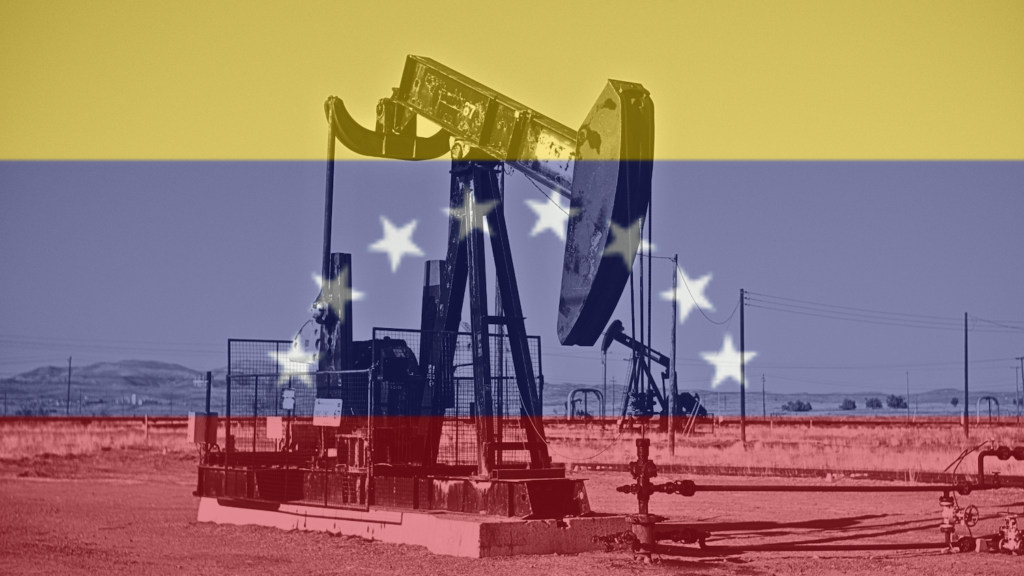22 Apr Trump’s Sanctions: The Accelerated Collapse of Venezuela’s Oil Industry
By,
Jesús Daniel Romero, Co-Founder and Senior Fellow, MSI²
The sanctions imposed by President Donald Trump’s administration on Venezuela’s oil industry—intensified since 2017 and further tightened in 2025—have deepened the country’s economic, productive, and geopolitical challenges.
These measures, which include the revocation of licenses for companies such as Chevron, Repsol, and Eni, and the imposition of 25% tariffs on Venezuelan crude oil imports, are compounded by internal policies of the Venezuelan government that aggravate the crisis (Parraga, 2025; U.S. Department of the Treasury, 2019). This summary analyzes the devastating effects on production, the economy, infrastructure, international markets, shortages, and humanitarian risks, offering mid-term projections.
Impact on Oil Production
The sanctions have reduced Venezuela’s oil production by an estimated 100,000 to 300,000 barrels per day—roughly 25% of its current capacity—due to the withdrawal of foreign companies that had been operating with Petróleos de Venezuela (PDVSA) (Parraga, 2025). The lack of diluents and technology further limits PDVSA’s operations. If this trend is not reversed, production could drop to 650,000 barrels per day in the coming months (Atlantic Council, 2024).
Economic Effects
The loss of oil revenues and foreign currency threatens to further shrink the economy. Companies like Chevron had provided significant cash flow to the currency market, stabilizing exchange rates and containing inflation (Parraga, 2025). Without these resources, a GDP contraction of 2–3% is projected for 2025, with inflation possibly surpassing 100% annually (International Monetary Fund, 2024).
Deterioration of Oil Infrastructure
PDVSA’s infrastructure, already weakened by years of underinvestment, is experiencing accelerated collapse. Sanctions have restricted access to spare parts and services from companies such as Halliburton and Schlumberger, increasing the risk of oil spills and well closures (Reuters, 2019). Incidents like those at the Amuay refinery reflect the inability to carry out preventive maintenance (Council on Foreign Relations, 2024).

Impact on International Markets
The sanctions have disrupted regional markets dependent on Venezuelan oil products. Brazil faces fertilizer shortages that affect its agricultural output, while Colombia may see delays in infrastructure projects due to a lack of asphalt (Parraga, 2025). Venezuela has tried to redirect exports to China with discounts of up to 30%, significantly reducing fiscal revenues (Atlantic Council, 2024).
Shortages and Their Effects
The decline in production and government revenue has caused severe shortages of fuel, food, and medicine. Gasoline and diesel scarcities disrupt transportation, raising the cost of basic goods by up to 200% (Human Rights Watch, 2024). A lack of foreign currency hampers the import of medical supplies, leaving 70% of hospital equipment non-operational. Food insecurity now affects 30% of the population (United Nations, 2024).
Humanitarian Disaster Risk
With 82% of the population living in extreme poverty, shortages threaten the country’s health and food systems (United Nations, 2024). The collapse of electricity and water supplies could spark protests and trigger a new wave of migration, adding to the 7.7 million Venezuelans who have already fled the country (Human Rights Watch, 2024).
Limitations of Traditional Allies
Support from Russia, China, and Iran is largely symbolic rather than operational. Moscow faces its own sanctions; Beijing is cautious due to legal uncertainties; and Tehran, while sharing refining technology, lacks the capacity for significant investment (Atlantic Council, 2024). Internally, cracks are emerging within the regime’s strategy to confront sanctions (Council on Foreign Relations, 2024).
Mid-Term Projections
The oil sector could contract by up to 20% in 2025. The exit of international partners, the exodus of technical talent, and the lack of external financing all contribute to the fragility of the energy system. The bolívar will continue to depreciate, further limiting access to essential goods and driving inflation (IMF, 2024; IEA, 2024).
Conclusion
The Trump administration’s escalation of sanctions, intended to weaken the Maduro regime, has triggered a multi-sector collapse that directly harms the Venezuelan population. The “maximum pressure” strategy may be undermining the very foundations of a future economic recovery. The oil industry—the backbone of the nation—now faces an unprecedented structural breakdown.
Strategic Recommendations
- Establish humanitarian corridors to allow the delivery of medicines, food, and fuel without benefiting regime elites.
- Reevaluate sectoral sanctions, permitting strictly humanitarian and technical exceptions to prevent irreversible catastrophe.
- Provide technical assistance through international or neutral regional actors to sustain minimum operations in critical sectors.
- Promote a multilateral diplomatic strategy—engaging Brazil, Colombia, Mexico, and the European Union—to encourage a political transition with realistic incentives.
- Support a roadmap for restructuring PDVSA in the mid-term, emphasizing governance, transparency, and reintegration into global markets.
References
Atlantic Council. (2024, April 18). Experts react: The US just reimposed sanctions on Venezuela. What does this mean for energy markets and Venezuela’s election? https://www.atlanticcouncil.org
Council on Foreign Relations. (2024, July 30). Venezuela: The rise and fall of a petrostate. https://www.cfr.org
Human Rights Watch. (2024). World report 2024: Venezuela. https://www.hrw.org/world-report/2024/country-chapters/venezuela
International Energy Agency. (2024). Oil market report – March 2024. https://www.iea.org/reports/oil-market-report-march-2024
International Monetary Fund. (2024). World economic outlook: Balancing risks. https://www.imf.org/en/Publications/WEO/Issues/2024/04/16/world-economic-outlook-april-2024
Parraga, M. (2025, March 29). U.S. to revoke authorizations to foreign partners of Venezuela’s PDVSA, sources say. Reuters. https://www.reuters.com/business/energy/us-revoke-authorizations-foreign-partners-venezuelas-pdvsa-2025-03-29/
Reuters. (2019, January 30). Factbox: U.S. sanctions on Venezuela’s oil industry. https://www.reuters.com/article/us-venezuela-politics-usa-sanctions-factbox-idUSKCN1PO2A8
United Nations Office for the Coordination of Humanitarian Affairs. (2024). Venezuela: Humanitarian response plan 2024. https://www.unocha.org/venezuela
U.S. Department of the Treasury. (2019, January 28). Treasury sanctions Venezuela’s state-owned oil company Petroleos de Venezuela, S.A. https://home.treasury.gov/news/press-releases/sm594
